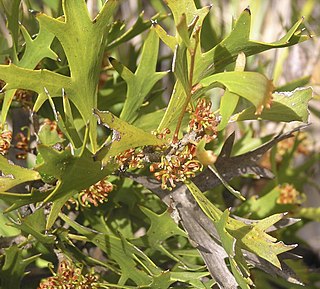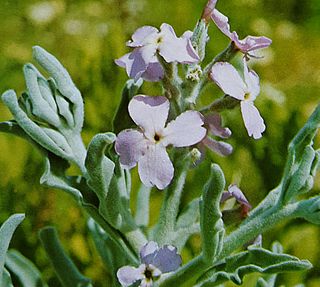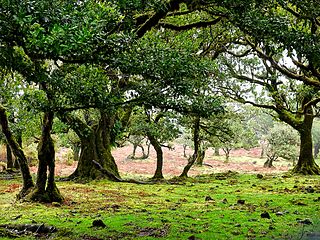
Matthiola, is a genus of flowering plants in the mustard family Brassicaceae. It was named after the Italian naturalist Pietro Andrea Mattioli (1501-1577). This genus contains about 48 to 50 species of annual, biennial and perennial herbaceous plants and subshrubs. Many are cultivated for their heavily scented, colorful flowers.

Gai lan, kai-lan, Chinese broccoli, Chinese kale, or jie lan is a leaf vegetable with thick, flat, glossy blue-green leaves with thick stems, and florets similar to broccoli. Another Brassica oleracea cultivar, gai lan is in the group alboglabra. When gone to flower, its white blossoms resemble that of its cousin Matthiola incana or Hoary Stock. The flavor is very similar to that of broccoli, but slightly more bitter. It is also noticeably stronger than broccoli.

Matthiola longipetala, known as night-scented stock or evening stock, is a species of ornamental plant.

Hakea bucculenta, commonly known as red pokers, is a large shrub in the family Proteaceae endemic to Western Australia. A spectacular ornamental shrub with red or orange flowers that appear in rod-like blooms in leaf axils for an extended period from May to November.

Hakea archaeoides is a large shrub or small tree commonly known as Big Nellie hakea and is endemic to forest areas on the north coast of New South Wales, Australia. It has clusters of red and greenish yellow flowers in the flowering season.

Matthiola incana is a species of flowering plant in the cabbage family Brassicaceae. Common names include Brompton stock, common stock, hoary stock, ten-week stock, and gilly-flower. The common name stock usually refers to this species, though it may also be applied to the whole genus. The common name "night-scented stock" or "evening-scented stock" is applied to Matthiola longipetala. It is a common garden flower, available in a variety of colours, many of which are heavily scented and also used in floristry.

Helichrysum melitense, the Maltese everlasting, is a species of flowering plant in the family Asteraceae and is endemic to Malta, specifically on the island of Gozo. It can be found in Dwejra, and in cliffs in Gozo near Fungus Rock. Its natural habitats are Mediterranean-type shrubby vegetation on Coastal garigue and vertical sheer cliffs. Recently, it was recorded in new locations on the island of Gozo. This species is on the decline in the wild, and it is threatened by habitat loss. It is very easy to cultivate, and it is gaining ornamental popularity amongst the locals.

Dactylorhiza foliosa, the Madeira orchid or leafy orchid, is a species of flowering plant in the family Orchidaceae, endemic to the Portuguese Island of Madeira in the eastern Atlantic Ocean. It is a tuberous herbaceous perennial growing to 60 cm (24 in) and producing spikes of intense, magenta-pink flowers in late spring.

Hakea epiglottis is a shrub commonly known as beaked hakea or needlebush hakea and is endemic to Tasmania where populations consist of functional unisexual plants. In a 1989 publication by John Wrigley & Murray Fagg states specimens at Wakehurst Place, an annexe of Kew Gardens London are specimens believed to be 60-70 years old measuring 3 m (9.8 ft) high and wide.

Leucoanthocyanidin (flavan-3,4-diols) are colorless chemical compounds related to anthocyanidins and anthocyanins. Leucoanthocyanins can be found in Anadenanthera peregrina and in several species of Nepenthes including N. burbidgeae, N. muluensis, N. rajah, N. tentaculata, and N. × alisaputrana.
Hedera maderensis, the Madeiran ivy, is a species of ivy which is native to the Atlantic coast in Madeira island. It is a plant of botanical family Araliaceae, species endemic to the island of Madeira with the name: Hedera maderensis. Formerly a subspecies named Hedera maderensis iberica, one iberian subspecies in west Iberian peninsula was subsequently classified as a distinct species. It is quite common in Madeira and lives in slopes rock, soil, trunks of trees especially in Laurel forest of Barbusano.

Hakea ceratophylla, commonly known as the horned leaf hakea, is a shrub in the family) Proteaceae and is endemic to the southwest of Western Australia. It is a stiff shrub with variably-shaped leaves that are sometimes lobed and flowers with white or rusty-coloured hairs.

Hakea conchifolia, commonly known as the shell-leaved hakea is a shrub in the family Proteaceae native to an area in the west coast of the Wheatbelt region of Western Australia. An attractive small species with unusual rigid leaves that encircle the flowers.

Hakea costata, commonly known as the ribbed hakea, is a shrub in the family Proteaceae native to Western Australia. A multi-stemmed small shrub producing attractive pink or white brush-like blooms rich in nectar from July to October.

Erysimum caboverdeanum is a species of flowering plants of the family Brassicaceae. The species is endemic to Cape Verde. It is listed as a critically endangered plant by the IUCN. The species was first described by Auguste Chevalier in 1935 as Matthiola caboverdeana; it was placed into the genus Erysimum by Per Øgle Sunding in 1974. Its local name is cravo-brabo. It is used in traditional medicine.

Matthiola crassifolia, the thick-leaved stock, is a species of plant in the family Brassicaceae.

The Madeira rockfish is a species of scorpionfish (Scorpaenidae) in the genus Scorpaena, found in the coastal waters of the eastern Atlantic Ocean and the Mediterranean Sea. This species reaches a length of around 14 centimetres (5.5 in) SL. The species was described by Achille Valenciennes in 1833 after a specimen from Madeira. Although S. maderensis is well represented in the areas that it is found, many key aspects of its biology are still unknown.

Ponta de São Lourenço is the easternmost point of the island of Madeira. It is inside the town of Caniçal and forms a part of the municipality of Machico. Its terrain are made up of rocks and herbaceous vegetation. Since 1982, the headland is a nature reserve, where it has the conservation of its endemic plants including Matthiola maderensis, Echium nervosum, and Andryala glandulosa, and it has fauna, including birds, insects, and molluscs. One of them is Monachus monachus, a seal. Marine fauna are in the waters surrounding the headland.

Matthiola sinuata, commonly known as sea stock, is a coastal plant in the family Brassicaceae.

The Madeira evergreen forests is a temperate broadleaf and mixed forests ecoregion of southwestern Europe. It covers the archipelago of Madeira and some nearby islands in the Atlantic Ocean. Laurel forest, known as laurissilva, once covered the islands. Over centuries the forests were mostly cleared. Madeira's remaining forests are now protected.



















